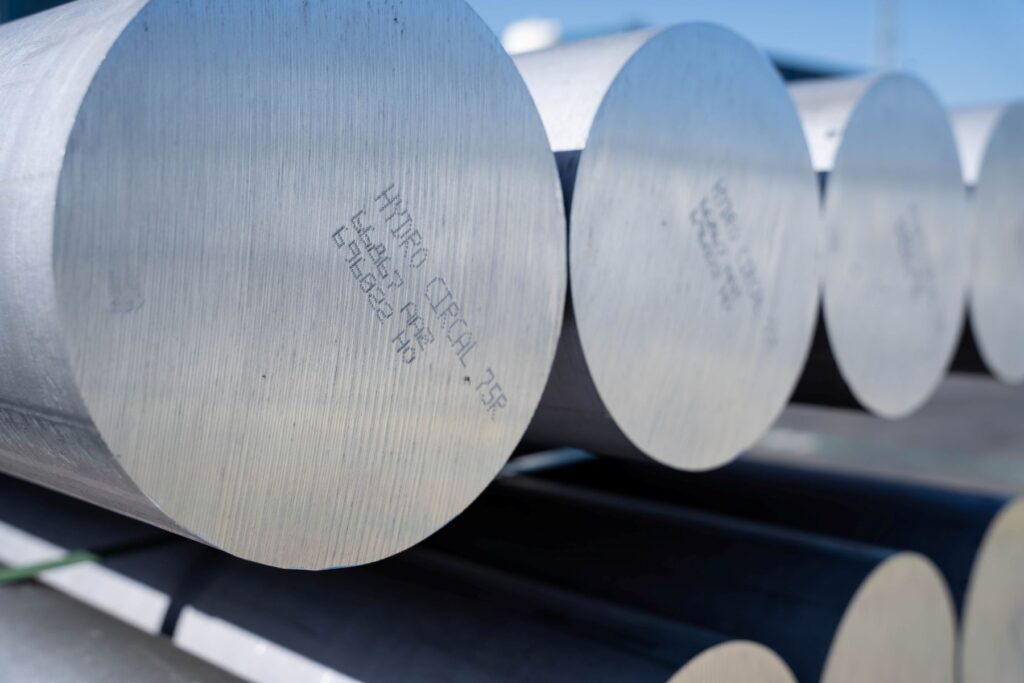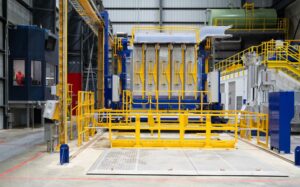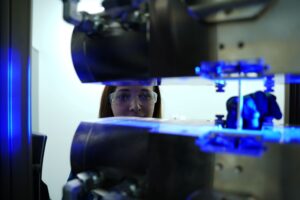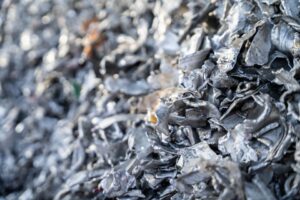
This Cassopolis recycling plant is the site of the first large-scale production of Hydro CIRCAL® extrusion ingot in North America.
Recycled materials are making a significant contribution to the automotive industry’s drive to meet its sustainability goals.
Aluminum is an integral part of the circular economy the industry is striving for. Now fully on stream, Hydro’s recycling plant in Cassopolis, Michigan, is setting new standards for high-quality, low-carbon aluminum.
With its benchmark-setting Hydro CIRCAL® products and proprietary technologies, the company believes it is redefining recycled aluminum’s potential in car manufacturing. Automotive Industries (AI) explores the transformative role of aluminum in enabling lightweight, energy-efficient, and more sustainable vehicles while showcasing Hydro’s leadership in recycling innovation.
AI asked Duncan Pitchford, President of Hydro Aluminum Metals, how the Cassopolis recycling plant is positioning the company as the leading producer of low-carbon, recycled aluminum in North America.
Pitchford: With the Cassopolis recycling plant now reaching full capacity, Hydro can produce over 2.2 billion pounds (one million metric tons) of recycling-based aluminum billets each year in the U.S, further strengthening its position as the largest producer of billets in the country.

Recycling scrap aluminum requires only 5% of the energy used to produce primary aluminum, saving resources and reducing greenhouse gas emissions.
This state-of-the-art recycling plant in Cassopolis marks the first large-scale production of Hydro CIRCAL® extrusion ingot in North America. Made with at least 75% post-consumer scrap, Hydro CIRCAL® brings old buildings and cars back to life as high-quality, certified low-carbon products for our most demanding customers in the automotive, building and construction and consumer durable markets.
The demand for more sustainably produced aluminum has been growing rapidly within virtually all our market segments – and among carmakers in particular – so we see this as a perfect time to introduce Hydro CIRCAL® in larger volumes to the North American market. And it is only the beginning.
AI: For what automotive applications will the Cassopolis output be used?
Pitchford: Having our industry-leading technology center (HATC) located next to our recycling plant strengthens our capabilities to deliver innovative aluminum products for more technically challenging applications in areas like automobile manufacturing.
We can produce significant volumes of Hydro’s proprietary HyCrushTM and HyBeamTM automotive alloys, made possible by the expertise of our technical team, for use in crash management systems and applications like battery boxes for electric and hybrid vehicles.
Hydro can also produce variants of these alloys such as Hydro CIRCAL®, containing at least 75% post-consumer scrap and the lowest carbon footprint in the aluminum industry. Cassopolis also utilizes Hycast’s proprietary low-pressure casting (LPC) technology, allowing production of more specialized, highly alloyed aluminum products.
In general, the plant will produce a range of 6xxx series aluminum alloys, from 6063 building and construction alloys to more specialized alloys for automotive applications such as 6008, 6110, and 6082, as well as alloys for wheel forging applications like 6099.
AI: How is Hydro CIRCAL recycled aluminum pushing the boundaries for high-quality recycled, low-carbon aluminum?
Pitchford: Hydro CIRCAL® aluminum extrusion ingot contains at least 75% post-consumer scrap, certified by third party auditors DNV, and has a market-leading CO2 footprint of just 1.9 kg CO2e/kg or less. The product is unique to Hydro.

It is an advanced material that achieves the industry’s highest level of post-consumer recycled content due to our advanced sorting and processing technology. This technology allows us to reuse materials in the U.S., rather than seeing them exported or worse yet put in a landfill, while enabling the repeatable production of high-quality aluminum with the strength and corrosion resistance needed in automotive components.
The Cassopolis plant is our first to produce Hydro CIRCAL® on a large scale in the U.S. Our delacquering and remelting technologies, brought over from Europe, will help enable annual production of 40,000 tons of Hydro CIRCAL®. This represents one-third of the plant’s total production capacity of 120,000 tons of recycled aluminum.
In time, we will expand Hydro’s overall capabilities in North America to produce Hydro CIRCAL® in line with market demand for the product.
AI: Can aluminum be infinitely recycled without any loss of quality?
Pitchford: Aluminum is light weight and infinitely recyclable. It keeps all its unique properties no matter how many times it is recycled. It is also highly corrosion resistant and can be formed into complex shapes.
For years, automakers have taken advantage of these properties to reduce the weight of combustion-powered vehicles, to lower fuel consumption and emissions, and increase performance.
Aluminum will play an even greater role in e-vehicles, where its combination of light weight, corrosion resistance, stiffness and energy-absorption properties make it ideal for structural applications.
With products like Hydro CIRCAL®, this combination of infinite recyclability and attractive material application properties come together in a unique material, based on 75% post-consumer scrap yet enjoying the same material properties as primary aluminum, to support automakers in uses like crash management systems, side sills, and other structural applications.
AI: Can the production and raw materials in Hydro CIRCAL® be traced and to what level?
Pitchford: Hydro CIRCAL® is our range of premium recycled aluminum, based on a minimum 75% scrapped products that have lived a previous and useful life. With advanced and patented sorting and processing technologies, Hydro recycles scrap into aluminum products for electric vehicles, designer furniture, consumer electronics and building facades.

The production and raw materials in Hydro CIRCAL® can be traced on an individual batch-by-batch level. It is delivered with an Environmental Product Declaration and verification statement from DNV.
AI: What is the importance of circular economy?
Pitchford: In a more unpredictable world with disrupted global supply chains, we need access to safe and reliable streams of raw materials. Keeping the materials, products or services, we produce in circulation for as long as possible, near to where they are used, makes our value chains more resilient and reduces waste.
In theory, most things can be recycled, but some materials are better suited for recycling than others. Aluminum is infinitely recyclable and retains all its qualities no matter how many times it’s recycled. This is why it’s called a permanent material. Moreover, when you recycle aluminum, you use 95% less energy than when producing aluminum the first time. This makes it an ideal material for the circular and low-carbon economy.
Many environmentally aware companies want to lower the carbon footprint by increasing the amount of recycled materials in their products. But circularity is tied to recapturing material from end-of-life products, recycling post-consumer scrap.
To truly understand the carbon footprint of your recycled aluminum, you need to know the kind and amount of scrap used in the recycling process. The ISO 14021 standard defines recycled content being made with post-consumer scrap and pre-consumer scrap.
When recycled aluminum is made from used windows or car parts, the material starts another life. Previously used aluminum in a product is referred to as “post-consumer” scrap, and its carbon footprint has already been accounted for, and is therefore close to zero.
Recycled aluminum made from production scrap or “pre-consumer” scrap is different. It is a result of inefficiency in the manufacturing process, it has not yet completed its life and must retain the carbon footprint of its original production process. If this isn’t done, there is a high risk that the material’s production emissions are not accounted for.
AI: What are Hydro’s ambitions for creating more recycled aluminum for automotive products?
Pitchford: Hydro wants to take the lead in promoting a more circular economy and decarbonizing industries, playing a key part in the green transition.
We are committed to a 30% reduction in our carbon emissions by 2030, with a goal of achieving net zero in Scope 1 and 2 carbon emissions by 2050. Hydro’s roadmap aims to create multiple pathways that can work together to help us reach near zero products today, and zero products in the future.

The fastest way to deliver zero-carbon aluminum is by recycling post-consumer scrap, which is aluminum that has lived a past life as beverage cans, windows, car parts, etc. With more than half of the aluminum we produce being recycled in facilities all over the world, our advanced technologies increase the share of aluminum that can be sorted and repurposed.
Aluminum is found in many places in battery-electric vehicles. Aluminum extrusions account for many applications, such as crash-management systems and other complex-shaped components and solutions.
In addition, we see that major sectors of the economy such as automotive and building and construction are starting to define roadmaps that call for lower carbon emissions during the manufacturing of products.
AI: In what ways can recycled aluminum support decarbonization in the automotive industry?
Pitchford: We help car manufacturers all over the world to lower their carbon footprint with our recycled products.
We are experiencing increasing demand for low-carbon and recycled aluminum in a range of market segments. Chief among these is the automotive market, where most OEMs have concrete goals for lowering the carbon footprint of the vehicles they produce, in both production and use phases.
Low-carbon aluminum products can meet these requirements. Aluminum plays a significant role in the lightweighting of electric and hybrid vehicles, which enables these cars to use fewer or smaller batteries to travel the same distances.
As car makers continue to make metal substitution decisions, particularly for e-vehicles, we are seeing a growing interest in our recycled products. A number of automotive industry customers have also expressed interest in Hydro CIRCAL® and we look forward to supplying these forward-leaning customers with cutting-edge material.
AI: What is next for Hydro?

Pitchford: Hydro launched its 2030 strategy one year ago, stepping up growth ambitions in aluminum recycling, extrusions and renewable power generation. Hydro will execute on its decarbonization roadmap, and contribute to nature positive and a just transition, while shaping the market for greener aluminum.
Hydro remains confident about recycling’s long-term value and its role in meeting the growing demand for low-carbon products, despite short-term pressures in the recycling market with tighter scrap supply and softer aluminum demand.
Hydro’s expertise in sourcing and processing complex scrap types positions our recycling activities for profitable growth, while advancing on ambitious 2030 targets. Hydro is on track and estimates to reach 700 kt of post-consumer scrap (PCS) capacity by year end 2024. The approved and planned projects confirm the lower end of the 2030 PCS target of 850 – 1,200 kt.











More Stories
Venti Technologies Wins Multiple Pinnacle Awards for Innovation and Achievement in Technology
Launch of AltaScient.ai: New horizons for Risk and Sustainability Analytics
Expert Tips on Detailing a Car